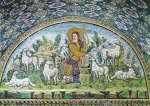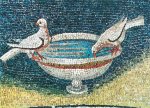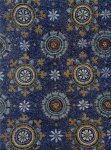accueil site > 45. Archives > 20. International > 02. GRUNDTVIG > 02. The languages of the blue > The stages of the blue > 12. December 15, 2010. Ravenna. Italy. Blue Colour and Light in the Mosaics (...)
12. December 15, 2010. Ravenna. Italy. Blue Colour and Light in the Mosaics of Ravenna.Saturday 18 December 2010
Michel Pastoureau traces a journey full of blue, from Antiquity to the present days, ranging from lack of interest to the success of the blue colour in Europe. My contribution follows a more limited course in Ravenna, the fifth to sixth century, following a reverse path of the blue colour, from ‘success’ to ‘reverse’ … In the mosaics that decorate the oldest monuments of Ravenna, artists have used a wide range of pieces made of blue-coloured glass with many shades and tones, which are in a natural harmony with tiles decorated with gold leaf. These, thanks to their yellow colour due to the gold leaf and amber tone that often characterizes the base of the molten glass, give a complementary relationship between blue and yellow, between blue and yellow-orange, well before the concept of complementarity officially appears in the theories of colour.
In the oldest monuments in Ravenna, such as the Neonian Baptistry or the Mausoleum of Galla Placidia, the characters are drawn in an intensely dark blue-coloured setting. A blue where stand out and shine gold tiles and of other colours such as white marble. This kind of decoration occupies the first place, and can be admired at the Mausoleum of Galla Placida where the barrel vaults are decorated with gold stars and arranged in a vibrant dark blue decor.
In successive monuments - Basilica of St. Vital, Church of St. Apollinaire Le Neuf, Basilica of St. Apollinaire en Classe - the ratio between the blue and gold seems to be reversed. Gold spreads and brightens the background while the blue characterises the details of scenes of no less importance. It is blue the globe on which sits the Christ in the apse of St. Vital and blue it is also the water where Christ is immersed in the scene of the baptism in the Baptistry of the Arians. But Heavens in the representations of the evangelists on the walls of the presbytery of the St. Vital Church are also blue, a blue preserving a naturalist value. And it is still in the presbytery that the vault, representing the Agnus Dei placed in an absolutely blue starry sky, recalls the starry vault of the Mausoleum of Galla Placidia of the previous century.
As for the sky, this relationship with the divinity and the transparency of light as a direct emanation of the divinity, there are the biblical texts that speak of the importance of the blue colour and of its relationship with precious stones. In Exodus one can imagine the vault of Heavens like a sapphire plate. Instead Ezekiel represents the vision of God sitting on a throne placed on a lapis lazuli, a stone used to produce an intense blue pigment.
The use of blue pigments is not unknown in Antiquity, even if, as noted by Michel Pastoureau, there was no specific terminology to indicate the category of blue in a univocal manner and besides blue is not included among the primary colours which are, according to the theories of Plato and Aristotle, white, black and red; finally, even if producing blue pigments is particularly difficult. Egyptian frit and azurite are pigments of mineral origin which are derived mainly from blue copper compounds. Indigo has a vegetable origin and comes from the fermentation of Indigofera tinctoria leaves. We have already mentioned lapis lazuli.
Regarding the pieces made of glass paste from early Christian and Byzantine mosaics, the blue colour is due to the presence not only of oxides of copper, iron and manganese, but especially of cobalt compounds. Cobalt has a particularly high colouring power, and even the presence of a small quantity in the molten glass, can produce an intense blue colouring. Among the ancient blue pigments there is the frit whose production will increase from Egypt to Greece and throughout the Roman Empire. The frit, by its nature and its methods of production, seems to have compromised its history in the production of blue tiny pieces from glass paste.
Vitruvius in the first century BC describes the fabrication technique after seeing it in a glass factory in Pozzuoli near Naples. The pigment is formed by cooking copper, Natrona and sand containing silica and calcite. But when, during the fifth and sixth centuries AD, sand without calcite will be used, we will obtain a green colour instead of blue and thus this new compound will experience a gradual decline being used only in some regions of Byzantine influence. The decline occurs at the time when the blue tiles used in the background mosaics of Ravenna give up to the tiles decorated with gold leaf.
Article by Daniele Torcellini. Picture: Mausoleum of Galla Placidia. Source: WIKIMEDIA















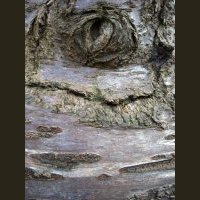
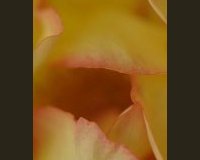
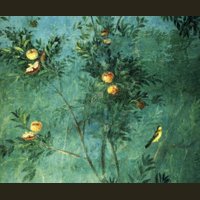
 Printable version
Printable version